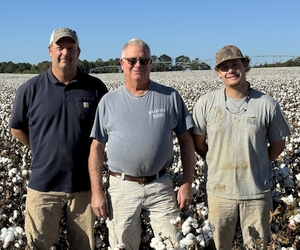Old Crop/New Crop Gap Narrows As the Market Watches Texas Weather
Cotton prices have been under pressure for two consecutive weeks. The May futures contract continues as the spot month, but the major business activity has shifted to July as May’s delivery period approaches. Thus, effectively, the July contract has become the spot month.
May’s run to 97 cents last month has now retreated to 89-90 cents, while the July contract is doing battle just to hold on to the 90 cent level.
The significant price inversion between the old crop July contract and the new crop December has declined to only eight cents. While this remains far too large a spread for an orderly futures market, the price spread has narrowed from some 11 to 15 cents at time during the past month. Nevertheless, the spread needs to drop to within a range of 400 to 600 points.
This price differential, combined with the ongoing call sales fixations by mills, has been primarily responsible for May/July contract dropping down to 90 cents. Yet, the market will remain very vulnerable to price volatility as unfixed on-call mills sales remain a primary bullish factor in the market.
These on-call sales have held the market up the past two months and provided ammunition for higher price runs. All is not lost just for now. However, a more bearish demand picture is surfacing – bearish relative to the July spending much time above 91-93 cents.
The new crop December contract has now climbed near 82 cents on the heels of the continued drought in Texas and the increasing weather reports that call for continued drought.
The four-year drought has been well documented over the past several years, but conditions are quickly returning to the wide ranging problems of 2011. Most growers comment that conditions are worse than in 2011, and for most growers that is the case. A few are marginally better off than in 2011. But without moisture in two to three weeks, they too will find themselves just as desperate as – or even more so – than in 2011.
Recall that weather forecasters marketed 2011 as a 50–year drought. Recall too, that, in 2009, a number of weather forecasters – to whom we did not listen – suggested that West Texas was entering in to a drought period that could last as long as eight years (technical analysis – weather, like prices, tends to move in cycles).
Recall that these forecasts were based on normal rainfall in Texas – the December 2014 contract was set to find a price high near 80 cents, the U.S. crop was estimated to range between 15.8 and 16.5 million bales, and U.S. carryover on July 31, was forecast to climb to between 5.3 and 5.8 million bales.
We laugh at ourselves with respect to “normal.” Normal, of course is a so-called long term average. Yet, with respect to Texas, the past four-year normal has been little more than zero-none-nada. Of course, there remain virtually 60 more days for the bulk of the vast Texas acreage to receive moisture. Thus, it is far too early to give up on a big crop in Texas. But time is burning, and the clock is ticking faster than most think. Yet, typically, a crop-saving rain near June 1 is considered “normal.”
Other fundamental news during the week related to the release of the USDA April Supply Demand Report. It adjusted U.S. production down to 12.9 million bales (300,000 lower), and in line with the final USDA Ginnings Report. This created the reduction in the aforementioned U.S. carryover. The change was expected and other report changes were minimal.
Additionally, the Chinese Reserve began offering cotton to Chinese textile mills at a marginally-reduced price. Mills purchased about half of the offered quantity, and the purchases included the right of the mill to import one bale of non-Chinese cotton for every four bales it purchased from the Reserve. The impact on New York was minimal, if any.
Look for the old crop/new crop spread to narrow. Yet, as fund managers exit old crop long position and mills fix on call sales, the nearby July could see a trading range between 86 and 95 cents.
Expect volatility.









